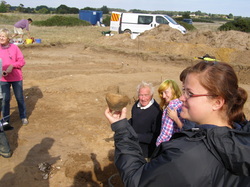
So here we are, at the end of a truly memorable 3 weeks, completing the obvious tasks before the site is restored to 'nature'. And - it wouldn't be ADLHS without this - finding some last minute excitement to add another twist to the Barbers Point saga, sending us off into winter dreaming of what the professionals' report will eventually say.
It was a beautiful day; about 26 stalwart volunteers made it to the site at some point, a couple of them suspiciously near to the bbq time. The blitz at the north east corner was completed with no major unexpected features discovered, although true to form Richard Newman dug up an excellent Ipswich ware pot base. In the graves the last skeleton remains were carefully lifted and plotted - the square 'pad' and related shapes in the feet area of the last grave proved to be simply compacted & stained sand, so no second treasures box there.
But at the foot of that treasures box graves we did find real excitement - it's been mentioned before in this blog that Anna was convinced from the start that the area immediately beyond it had 'something going on' and the imaginative volunteers amongst us were sure that the charcoal patch down at the grave foot had to be part of that 'something'. So yesterday we made a brief start exploring the surface before the rain drove us home. Today Anna and Nina undertook a beautifully executed section through the feature, (see below) and bingo! Its a substantial pit, with extensive charcoal remains at the base (tree rings clearly visible in finger tip sized pieces carefully bagged for the lab) and - wait for it - 3 pieces of prehistoric pottery immediately by the burnt area. Of course the experts will have to consider this in great detail, and presumably there will be carbon 14 dating, but the volunteers (and Sam Newton who just couldn't keep away) are convinced we have evidence of Neolithic settlement (as opposed to the passing hunters indicated by the flint arrow heads previously found). Sam offered a compete guess at 3000BC plus the persuasive comment "where there is a pot there must be a cupboard".
And here's another thought - in the Dictionary of English Place Names by A D Mills (OUP 1998) it is suggested that some of the river names we use today may have been in use among the early Neolithic inhabitants. One of these is the Itchen. In the entry for Iken, Mills says this is "possibly an ancient river-name identical with ITCHEN. This would have been the old name of the River Alde...". Another Neolithic connection to our site?
After a site tour, when Jezz asked the relevant volunteers to explain what had been found and how it fitted into the site context as a whole, Sam Newton then gave us a riveting talk at the cake cutting ceremony. He had brought his reconstruction of an Anglo Saxon harp or lyre, and for the final spine-tingling minutes, sang verses (and translations) from Beowulf about burial and the passage to the afterlife - fairly certainly the first time Saxon has been spoken and sung on that spot since about 750AD. No one present will ever forget it.
And now a final piece to this blog concerning the 'treasures box' grave. Because 'George' was the first grave explored in the 2013 dig, some of us named the others - just for ease of reference you understand. This one was called Edward Henry... Various passing comments have been made about the finds in it, but our apparent reticence about such a significant discovery deserves explanation - and a proper account of the find itself. We were obliged to remain silent for some days because the find had to be very painstakingly excavated, and like the 'coin' in the adjacent grave and the 'dagger' in the next, had to be left on site without full security during that time. Now that the dig is complete, and the site covered back over, we can give everyone a description composed by Val, who has had quite a lot of practice telling it to visiting dignitaries, academics - and all our friends the volunteers on site. This is her account:
"We’d just about given up on finding the mortal remains of Edward Henry even though we’d found a good number of coffin nails and the stain from the coffin itself. Our excavation was considerably deeper than nearby graves when I at last found the right leg and arm bones. David began to search for the skull and teeth while I investigated the feet – which turned out to be pretty well preserved. I started to find a number of pieces of wood and metal, about a finger’s length and width, with nails or studs in them, grouped in the area around the feet. We eventually concluded some days later that this was the remains of a small box. I say ‘some days later’ because everything had to be planned and drawn and measured before it could be lifted, so it was days before we really knew what was there. But by the end we had what we believe to be the contents of a ‘treasure box’ placed on the feet of a girl or woman (age as yet unknown – David didn’t find much of the head but there are teeth which may be used to age the body)
Within a small area there were several fragments of a necklace with two beads – one of which is blue glass. Nearby, a bronze ring of probable Roman origin (maybe a small terret ring, originally used on a harness) with a loop of iron and a pin attached to it (we don’t know if this is by accident or design) but it may have converted the ring into a piece of jewellery. When I found the spindle
whorl, which every girl and woman would need for spinning wool, we decided this must be Edwina rather than Edward. The other ‘treasures’ in her box included a small piece of blue Saxon glass which Sam Newton thought might be part of a palm cup; a piece of amber about the size of a sugar cube with a coating that made it much the same colour, a stone with a hole in it – like the spindle whorl but possibly a fossil sea urchin, and an egg.
The latter caused the most excitement so far – this egg, white and the size of a large chicken’s egg is 1300 years old but has somehow survived. There is a hole in the side of it about the size of a 50p piece and something white inside it – goodness knows what but I don’t think it is broken egg shell.
Anna managed to lift it in a block of sand and hopefully we will eventually find out just what sort of egg it is and even why it was placed there.
As we lifted the body, the grave gave up its final treasure: the last piece of the box which lay on Edwina’s feet has preserved a fragment of the shroud in which she was buried. The fragment is impressed on the iron and is no more than an inch long. It took Anna to spot it, but as you can imagine, this is an incredibly rare find and may perhaps add to our knowledge of Anglo-Saxon textiles.
This is a Christian grave in a Christian cemetery, but in the transition period between paganism and Christianity (maybe 615 – 700 AD) and it looks as though this family were hedging their bets here.
The finds have attracted lots of attention from academics and specialists and we now have to wait, patiently, for the conservation and analysis."
It was a beautiful day; about 26 stalwart volunteers made it to the site at some point, a couple of them suspiciously near to the bbq time. The blitz at the north east corner was completed with no major unexpected features discovered, although true to form Richard Newman dug up an excellent Ipswich ware pot base. In the graves the last skeleton remains were carefully lifted and plotted - the square 'pad' and related shapes in the feet area of the last grave proved to be simply compacted & stained sand, so no second treasures box there.
But at the foot of that treasures box graves we did find real excitement - it's been mentioned before in this blog that Anna was convinced from the start that the area immediately beyond it had 'something going on' and the imaginative volunteers amongst us were sure that the charcoal patch down at the grave foot had to be part of that 'something'. So yesterday we made a brief start exploring the surface before the rain drove us home. Today Anna and Nina undertook a beautifully executed section through the feature, (see below) and bingo! Its a substantial pit, with extensive charcoal remains at the base (tree rings clearly visible in finger tip sized pieces carefully bagged for the lab) and - wait for it - 3 pieces of prehistoric pottery immediately by the burnt area. Of course the experts will have to consider this in great detail, and presumably there will be carbon 14 dating, but the volunteers (and Sam Newton who just couldn't keep away) are convinced we have evidence of Neolithic settlement (as opposed to the passing hunters indicated by the flint arrow heads previously found). Sam offered a compete guess at 3000BC plus the persuasive comment "where there is a pot there must be a cupboard".
And here's another thought - in the Dictionary of English Place Names by A D Mills (OUP 1998) it is suggested that some of the river names we use today may have been in use among the early Neolithic inhabitants. One of these is the Itchen. In the entry for Iken, Mills says this is "possibly an ancient river-name identical with ITCHEN. This would have been the old name of the River Alde...". Another Neolithic connection to our site?
After a site tour, when Jezz asked the relevant volunteers to explain what had been found and how it fitted into the site context as a whole, Sam Newton then gave us a riveting talk at the cake cutting ceremony. He had brought his reconstruction of an Anglo Saxon harp or lyre, and for the final spine-tingling minutes, sang verses (and translations) from Beowulf about burial and the passage to the afterlife - fairly certainly the first time Saxon has been spoken and sung on that spot since about 750AD. No one present will ever forget it.
And now a final piece to this blog concerning the 'treasures box' grave. Because 'George' was the first grave explored in the 2013 dig, some of us named the others - just for ease of reference you understand. This one was called Edward Henry... Various passing comments have been made about the finds in it, but our apparent reticence about such a significant discovery deserves explanation - and a proper account of the find itself. We were obliged to remain silent for some days because the find had to be very painstakingly excavated, and like the 'coin' in the adjacent grave and the 'dagger' in the next, had to be left on site without full security during that time. Now that the dig is complete, and the site covered back over, we can give everyone a description composed by Val, who has had quite a lot of practice telling it to visiting dignitaries, academics - and all our friends the volunteers on site. This is her account:
"We’d just about given up on finding the mortal remains of Edward Henry even though we’d found a good number of coffin nails and the stain from the coffin itself. Our excavation was considerably deeper than nearby graves when I at last found the right leg and arm bones. David began to search for the skull and teeth while I investigated the feet – which turned out to be pretty well preserved. I started to find a number of pieces of wood and metal, about a finger’s length and width, with nails or studs in them, grouped in the area around the feet. We eventually concluded some days later that this was the remains of a small box. I say ‘some days later’ because everything had to be planned and drawn and measured before it could be lifted, so it was days before we really knew what was there. But by the end we had what we believe to be the contents of a ‘treasure box’ placed on the feet of a girl or woman (age as yet unknown – David didn’t find much of the head but there are teeth which may be used to age the body)
Within a small area there were several fragments of a necklace with two beads – one of which is blue glass. Nearby, a bronze ring of probable Roman origin (maybe a small terret ring, originally used on a harness) with a loop of iron and a pin attached to it (we don’t know if this is by accident or design) but it may have converted the ring into a piece of jewellery. When I found the spindle
whorl, which every girl and woman would need for spinning wool, we decided this must be Edwina rather than Edward. The other ‘treasures’ in her box included a small piece of blue Saxon glass which Sam Newton thought might be part of a palm cup; a piece of amber about the size of a sugar cube with a coating that made it much the same colour, a stone with a hole in it – like the spindle whorl but possibly a fossil sea urchin, and an egg.
The latter caused the most excitement so far – this egg, white and the size of a large chicken’s egg is 1300 years old but has somehow survived. There is a hole in the side of it about the size of a 50p piece and something white inside it – goodness knows what but I don’t think it is broken egg shell.
Anna managed to lift it in a block of sand and hopefully we will eventually find out just what sort of egg it is and even why it was placed there.
As we lifted the body, the grave gave up its final treasure: the last piece of the box which lay on Edwina’s feet has preserved a fragment of the shroud in which she was buried. The fragment is impressed on the iron and is no more than an inch long. It took Anna to spot it, but as you can imagine, this is an incredibly rare find and may perhaps add to our knowledge of Anglo-Saxon textiles.
This is a Christian grave in a Christian cemetery, but in the transition period between paganism and Christianity (maybe 615 – 700 AD) and it looks as though this family were hedging their bets here.
The finds have attracted lots of attention from academics and specialists and we now have to wait, patiently, for the conservation and analysis."
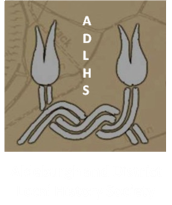
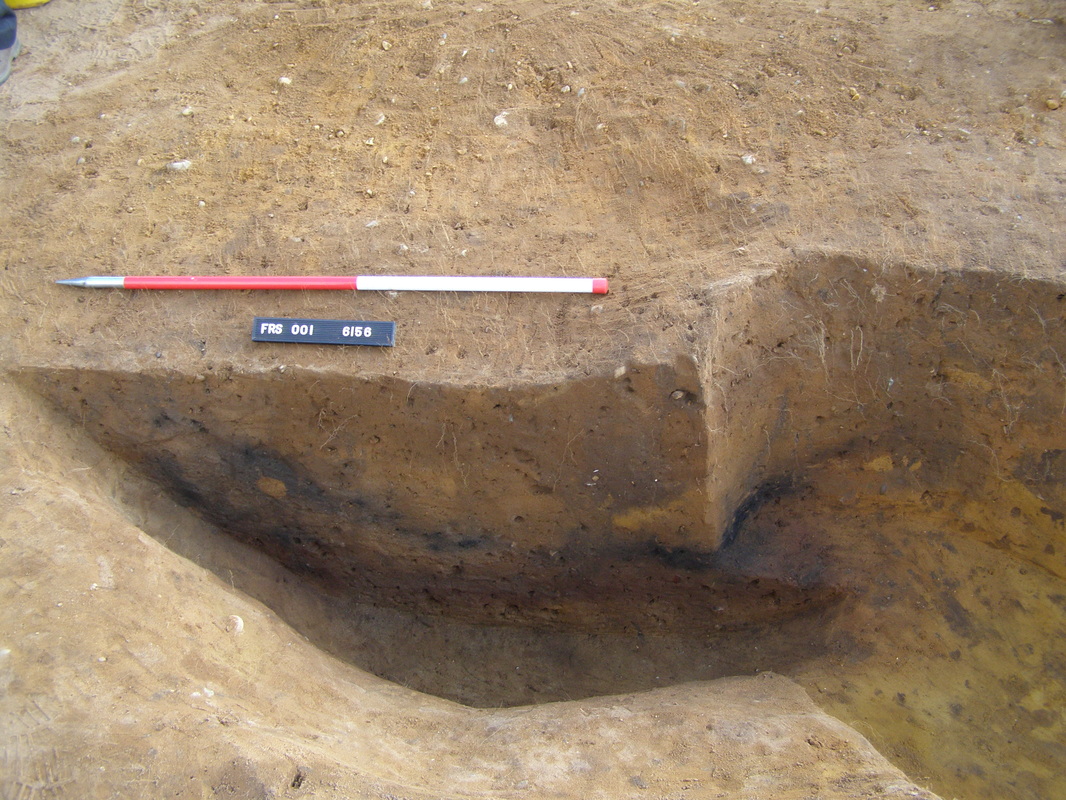
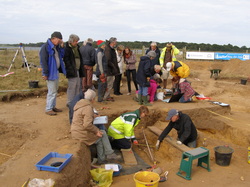
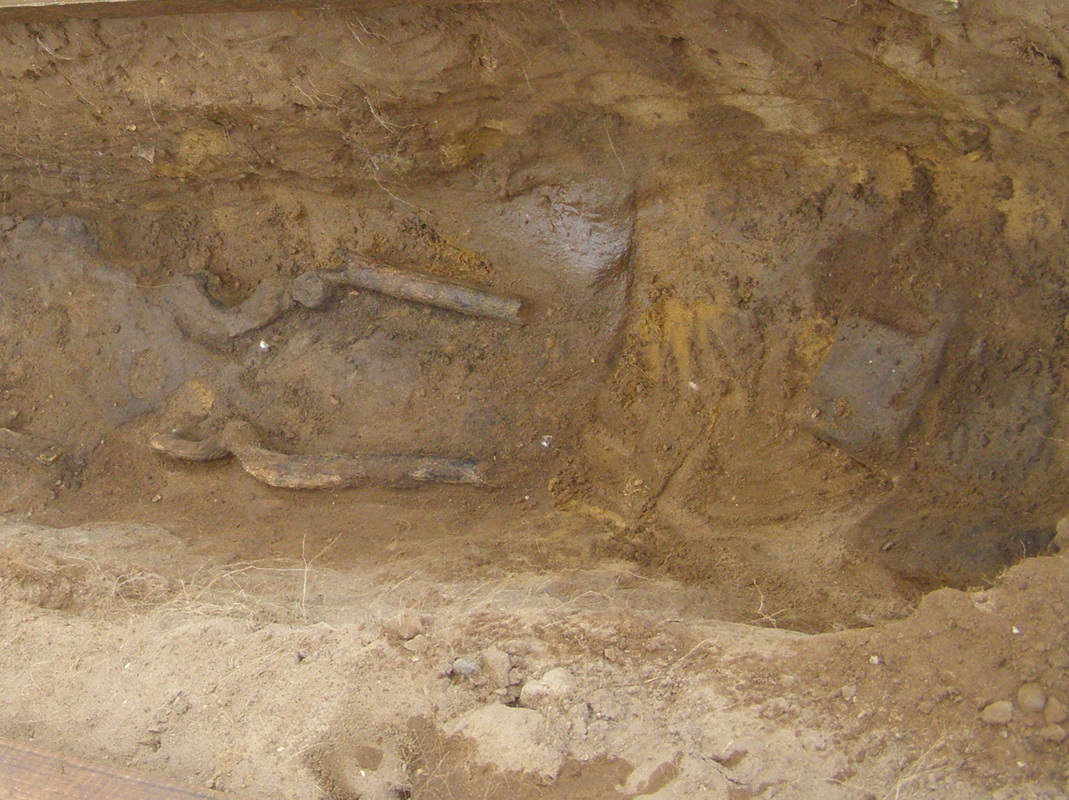
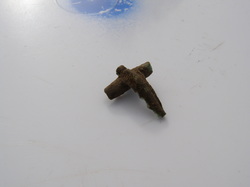
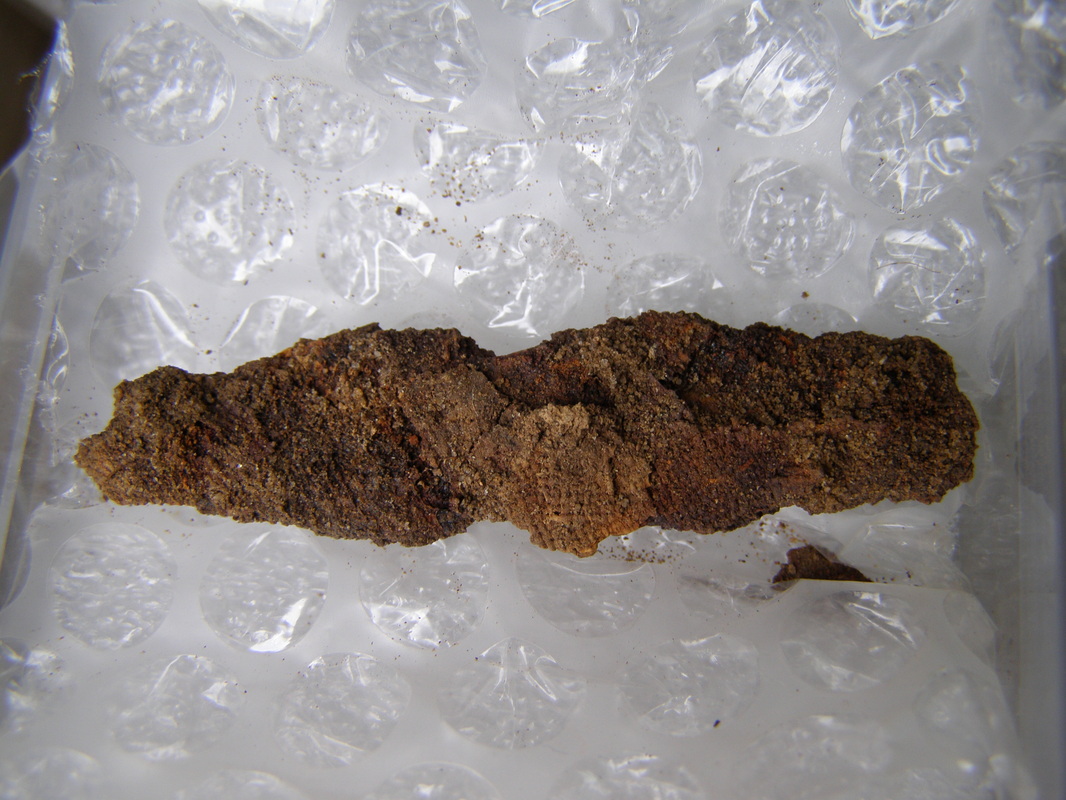
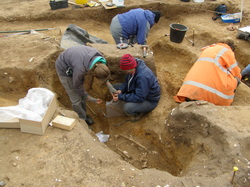
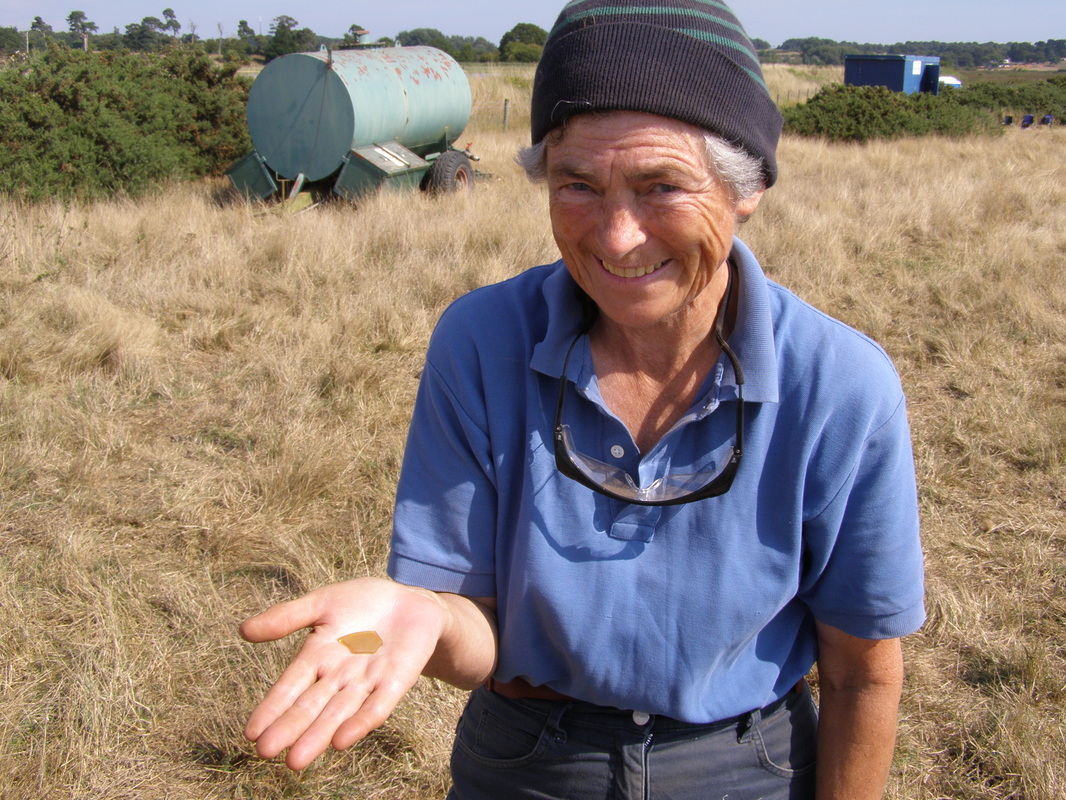
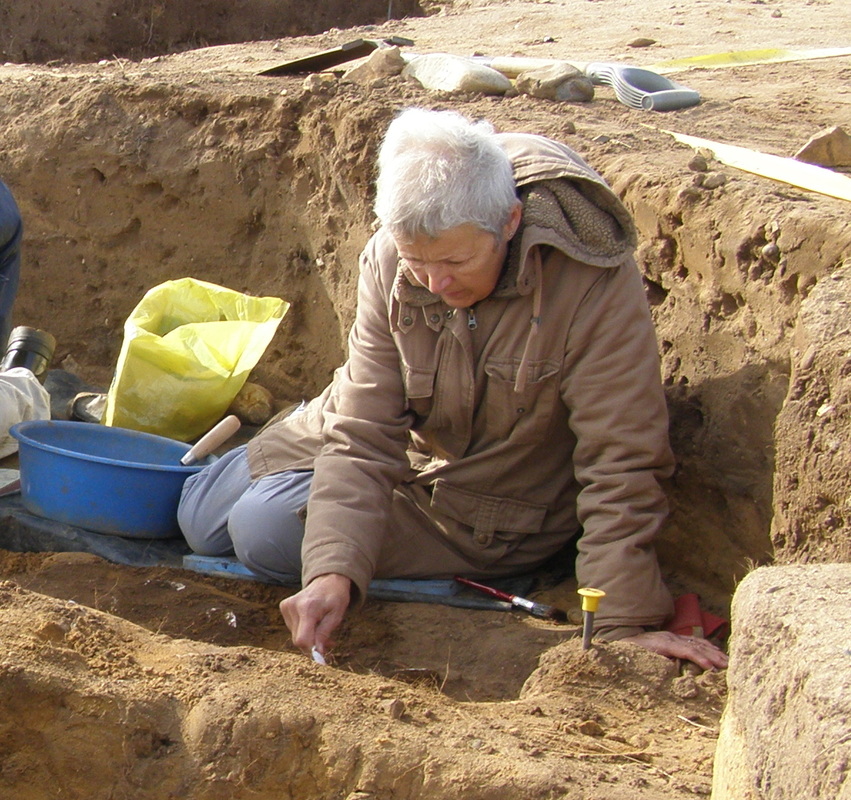
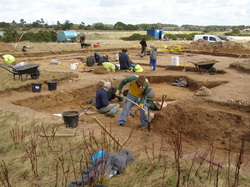
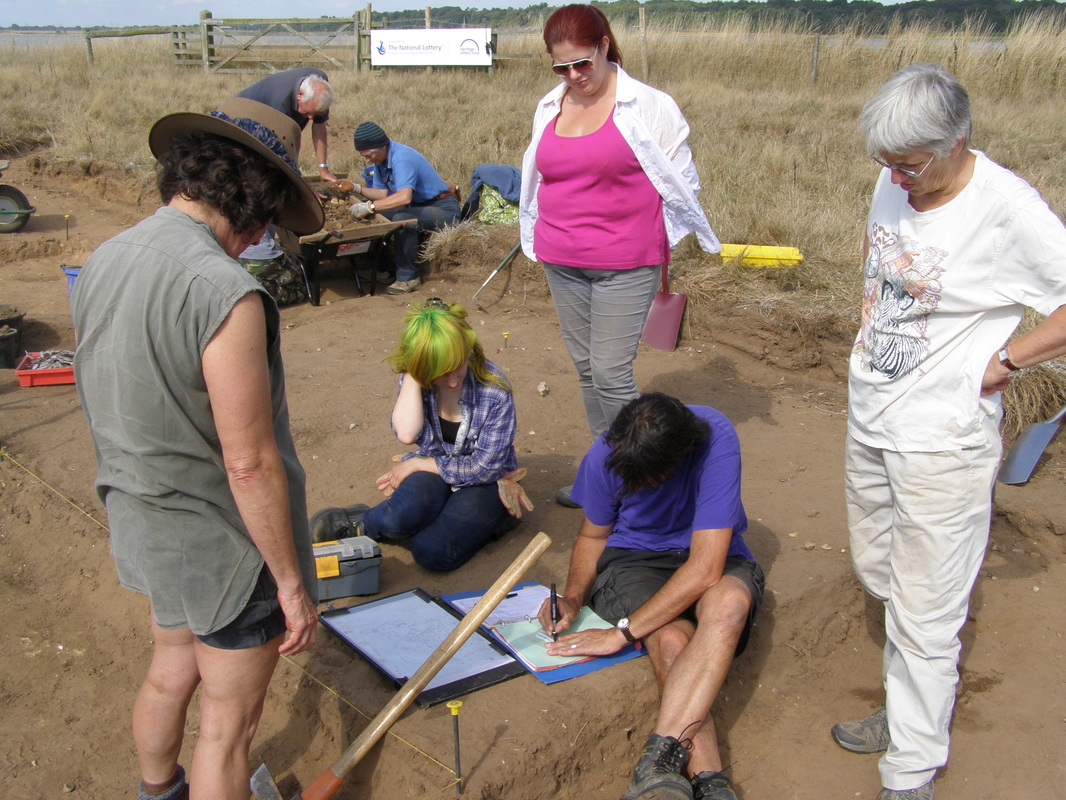
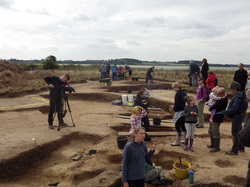
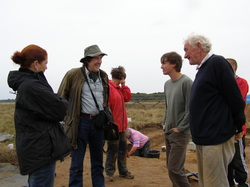
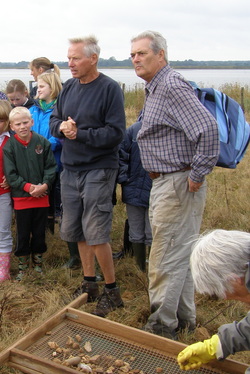
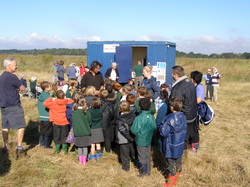
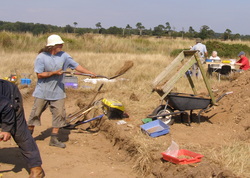
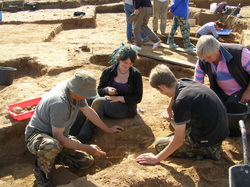
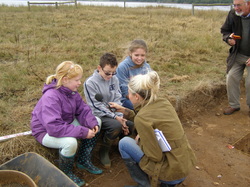
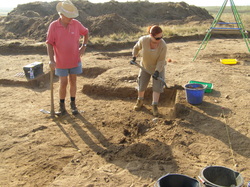
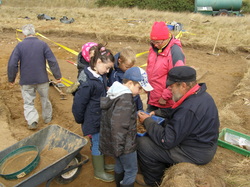
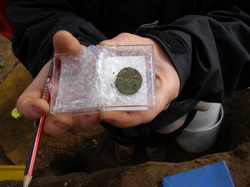
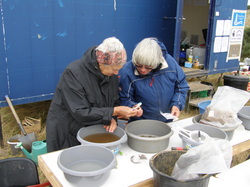
 RSS Feed
RSS Feed